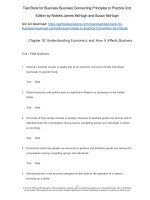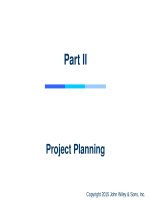Lecture Project management in practice (Fifth Edition) – Chapter 3: Project activity and risk planning
Bạn đang xem bản rút gọn của tài liệu. Xem và tải ngay bản đầy đủ của tài liệu tại đây (671.91 KB, 32 trang )
Project Management in Practice
Fifth Edition
Chapter 3
Project Activity and Risk
Planning
Copyright © 2014 John Wiley & Sons, Inc.
31
Two Extremes Approaches to
Planning
•
“Ready, fire, aim”
–
•
•
Tom Peters
“Paralysis by analysis”
There is a happy medium that everyone
would like to strike
32
The Basis of a Project Planthe
“Project Charter”
•
•
•
•
Primary function of a project plan is to
serve as a roadmap
Should include the business case and
strategic reasons for the project
Should contain sufficient information to
know the status of the project at any time
Also needs the project’s history to date
33
Categories of Elements Required in
the Project Charter
1.
2.
3.
4.
5.
6.
7.
8.
Purpose
Objectives
Overview
Schedules
Resource requirements
Personnel and stakeholders
Risk management
Evaluation methods
Slide on each
34
Purpose
•
Business case for the project
–
–
–
–
–
•
Strategic reasons for the project
Expected profitability
Competitive effects
Desired scope
Any other technical results
Intent is to communicate to stakeholders the
reasons for the project
35
Objectives
•
•
Another name is project mission statement
More detailed description of the…
–
–
–
•
Scope
Deliverables
Outcomes
Communicate to project team members
what will be done to achieve the overall
project objectives
36
Overview
•
•
•
•
•
•
•
Intended for senior management
Brief description of project
Deliverables
Milestones
Expected profitability and competitive effects
Technological and managerial approaches
Agreements with the client or any third party
37
Schedule
•
•
•
Summary of schedules and milestones
Work breakdown structure (WBS)
Time to complete each task
38
Resource Requirements
•
Estimates of project expenses
–
•
•
•
•
Capital and operating
Costs associated with each task
Overhead and fixed charges
Appropriate account numbers
Project budget
39
Personnel and Stakeholders
•
•
•
•
Stakeholders, sponsor, project manager, and
some team members
Special skill requirements
Necessary training
Special legal arrangements
–
Such as nondisclosure agreements
310
Risk Management
•
Listing of potential disasters
–
–
•
Major and minor
Late subcontractor deliveries, bad weather,
unreasonable deadlines, equipment failure,
changes in project scope
Contingency plans are described
–
–
Does not stop disasters
Softens the impact
311
Evaluation Methods
•
•
Evaluation procedures and quality standards
Procedures for monitoring, collecting, and
storing data on project performance
312
The Planning ProcessOverview
1.
2.
3.
4.
5.
6.
7.
8.
Develop and evaluate the concept of the project
Carefully identify what project deliverables must
have to be successful
Create a system
Test the prototype
Integrate the deliverable into target system
Validate the deliverable
Let client test it
Make sure client understands operating and
maintenance requirements
313
The Planning ProcessNuts and
Bolts
•
•
Once approved, project should have a launch
meeting
New project manager should review project
objectives
1.
2.
3.
•
Make sure they understand
Identify important senior managers
Determine if anything is atypical
Senior manager introduces project to group
–.
Project manager chairs launch meeting
314
Results of the Launch Meeting
1.
2.
3.
The project’s scope is understood
Various functional managers understand
their responsibilities and have committed
to develop an initial task and resource
plan
Any potential benefits to the organization
outside the scope are noted
315
Sorting Out the ProjectThe Work
Breakdown Structure (WBS)
•
•
•
Inadequate upfront planning is a primary
contributor to the failure of a project
A primary purpose of the WBS is to ensure
that no task is overlooked
Every task, no matter how small, should be
listed
–
•
Along with material and human resources
This is a nontrivial task
316
A Sample (Partial) WBS
Figure 31
317
Notes on WBS
•
Microsoft Project (MSP) will make a WBS list at the touch
of a key
–
•
•
•
But not a treechart
At any given level, the “generality” or “degree of detail”
of the tasks should be roughly at the same level
The breakdown of level 1 tasks should be delegated to
someone who will carry out the level 2 tasks
The job of planning should be delegated to the lowest
competent level
318
Extensions of the Everyday WBS
•
•
WBS generally oriented towards deliverables
Can be reshaped with some additional data often
not included in the WBS
1.
2.
3.
4.
•
Estimates of resources for each task
Estimates of the time for each task
Who has responsibility for each task
Sequence information for each task
Increases it orientation toward planning and
administration
319
A Modified WBS for Improving
Staff Orientation
Table 32 (Partial)
320
More on the Work Breakdown
Structure and Other Aids
•
•
•
RACI Matrix is a table
Project tasks derived from the WBS listed
in rows and departments and individuals in
the columns
Helps organize the project team
321
The RACI Matrix
Figure 35
322
A WholeBrain Approach to Project
Planning
•
•
•
Mind mapping is a visual approach that closely
mirrors the way the human brain records and
stores information
In addition to its visual nature, this methodology
has the advantage of tapping in to the creative
potential of multiple team members
Mind mapping is an entertaining approach that
helps generate enthusiasm and involvement
323
Sample Mind Map
Figure 39
324
Risk Management
1.
2.
3.
Risk identification
Risk analysis
Response to risk
325









